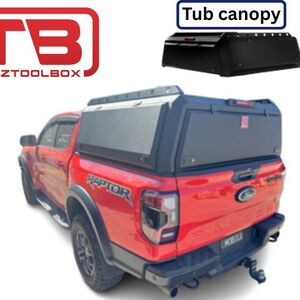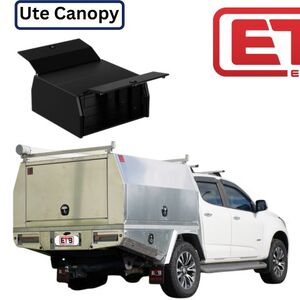Tub Canopy Vs Ute Canopy What’s the Real Difference


When it comes to customizing your Ute for work, adventure, or daily practicality, one major decision stands out — choosing between a tub canopy and a Ute canopy. At first glance, these two options might seem similar. After all, both serve to enclose the rear space of your Ute and provide storage protection. But the real difference lies in structure, usability, strength, and long-term value. If you’re a tradie carrying tools, a weekend camper needing secure gear storage, or someone building a mobile workspace, making the right canopy choice can directly impact your vehicle’s performance and functionality.
Many buyers end up regretting their first choice because they didn’t know what questions to ask. Do you need full internal shelving? Will your factory tub hold up under load? Can you access your equipment quickly from multiple sides? These are just a few factors to consider before spending thousands.
This introduction sets the stage for a clear, no-nonsense breakdown of tub canopies versus Ute canopies. We’ll cut through the jargon and hype to deliver real-world comparisons backed by practical examples and factual data.
Tub Canopy Vs Ute Canopy What’s the Real Difference
In this guide, we will explain everything you need to know to make the best decision for your vehicle and your lifestyle.
1. What Is a Tub Canopy?
A tub canopy is a vehicle accessory designed to mount directly onto the factory-installed Ute tub. It is a removable structure made of materials such as fiberglass, ABS plastic, or aluminum, and it covers the open cargo area to provide weather protection and secure storage. The main appeal of a tub canopy is its ability to retain the original tub, making it easy to install or remove without significant modifications to the vehicle.
Tub canopies are often equipped with rear-hinged or lift-up glass windows, and some models offer side access panels, roof racks, or window mesh screens. These canopies are suitable for light-duty applications, such as weekend getaways, carrying pets, or basic tool storage for casual tradespeople. They are ideal for Ute owners who want to maintain the factory setup while gaining extra weatherproof storage.
2. What Is a Ute Canopy?
A Ute canopy, often referred to as a full canopy, replaces the vehicle’s factory tub with a custom flat tray. The canopy is then installed directly onto the tray, forming a fully enclosed storage solution that offers higher structural strength, greater payload capacity, and enhanced modular features. Ute canopies are commonly fabricated from aluminum, steel, or composite materials, making them more durable and suited to heavy-duty applications.
This setup allows for extensive customization, such as installing shelving units, drawer systems, fridge slides, power systems, and solar panels. Ute canopies are popular among tradies, campers, tourers, and field workers due to their long-term reliability and adaptability. Unlike tub canopies, Ute canopies are designed for permanent installation and often become a critical part of the vehicle’s functionality.
3. Installation Differences
Installing a tub canopy is typically a quick and simple process. It involves mounting the canopy onto the existing tub using clamps or bolts. Most installations can be completed within 1–2 hours using standard hand tools. No structural modifications are needed, making it ideal for users looking for a non-permanent upgrade.
On the other hand, installing a Ute canopy requires removing the factory tub and replacing it with a custom tray. This process is more technical and time-consuming, often requiring professional installation. The tray must be securely mounted to the chassis, and the canopy bolted and sealed for long-term use. Additional tasks, such as wiring accessories, installing electrical systems, and fitting storage solutions, can extend the process to 6–12 hours or more.
| Feature | Tub Canopy | Ute Canopy |
|---|---|---|
| Installation Time | 1–2 hours | 6–12 hours |
| Required Modifications | None | Tub removal, tray fit |
| Tools Needed | Basic tools | Advanced/professional |
| Skill Level | DIY-friendly | Requires professional |
4. Structural Durability
When it comes to strength and durability, Ute canopies offer a significant advantage. They are typically constructed from 2.5mm aluminum or galvanized steel, which provides excellent resistance to heavy loads, impacts, and long-term wear. Their reinforced frames are designed to withstand off-road driving, industrial use, and continuous exposure to the elements.
Tub canopies, especially those made of fiberglass or plastic, are less robust. While they perform well under moderate use, they may be vulnerable to cracks, warping, or damage under heavy loads or rough terrain. Even aluminum tub canopies are limited by the structural integrity of the factory tub beneath them, which isn’t designed to handle concentrated stress.
Ute canopies offer higher weight limits, stronger mounting systems, and better protection in extreme conditions, making them more suited to professional use and remote travel.
5. Storage Flexibility and Interior Customization
Tub canopies have limited internal space due to the shape and depth of the factory tub. Their floor layout is fixed, and the wheel arches reduce usable volume. While some owners install simple shelves or storage boxes, most customization is restricted. Access is usually from the rear tailgate, with optional side windows or vents available at extra cost.
Ute canopies, by contrast, are fully modular. Because they are built on a flat tray, the interior can be customized with drawers, shelving, false floors, tool mounts, and slide-out systems. Access points are typically available on three sides (rear and both sides), allowing better reach and organization. They can also be wired with lighting, power inverters, batteries, and fridge units, offering maximum flexibility for work or camping.
6. Payload and Load Distribution
One of the most critical differences lies in load capacity and distribution. The factory tub is not engineered to carry excessive weight, and as such, tub canopies are limited in payload. Most are rated for 300–400kg total, including gear and any roof load.
Ute canopies are mounted on custom steel or alloy trays that distribute weight more evenly across the vehicle chassis, allowing for much higher load capacities — often exceeding 900kg. These canopies are built to support roof racks, water tanks, spare wheels, and even roof-top tents, making them far more capable for demanding applications.
| Feature | Tub Canopy | Ute Canopy |
|---|---|---|
| Payload Capacity | 300–400kg | 800–1000kg+ |
| Roof Load Limit | 100–150kg | 400–500kg |
| Load Distribution | Limited to tub walls | Across full chassis |
7. Weatherproofing and Security
Tub canopies offer basic weatherproofing, often relying on rubber seals and window locks. However, the factory tub’s tailgate is a common source of dust and water ingress, particularly on dirt roads. In terms of security, fiberglass canopies are vulnerable to forced entry, and the locks are often basic key systems.
Ute canopies provide superior protection from weather and theft. They include dual compression seals, reinforced hinges, and multi-point locking systems. Many models also support central locking, alarm integration, and dustproof pressurization systems. If your gear includes power tools, electronics, or valuables, a Ute canopy offers far more peace of mind.
8. Fuel Efficiency
Tub canopies are generally more aerodynamic because they retain the factory body lines and integrate more smoothly with the cab. They may slightly reduce drag, especially if roof racks are not installed, potentially improving fuel efficiency by 0.2–0.5 L/100km under certain driving conditions.
Ute canopies, especially box-shaped models, can create more drag, particularly if loaded with roof accessories. They may increase fuel consumption by 0.7–1.2 L/100km, though this varies depending on weight and shape. Aerodynamic features like angled fronts, wind deflectors, and low-profile designs can help reduce this effect.
9. Resale Value and Insurance
Tub canopies are easier to remove and resell separately, preserving the vehicle’s original body. This makes them a resale-friendly option for those who plan to sell or trade in the vehicle in the future. Insurance premiums are generally lower since the factory tub is retained, and there’s minimal risk of structural failure.
Ute canopies add long-term value for buyers seeking a turnkey work or touring setup. While the initial investment is higher, it can enhance appeal in niche markets such as tradespeople or off-road enthusiasts. However, they must be declared to insurers, and added features (e.g., electricals, drawers) may require detailed documentation to be covered in full.
10. Final Cost Summary
Below is a breakdown of the costs involved in each type of canopy setup:
| Feature | Tub Canopy | Ute Canopy |
|---|---|---|
| Canopy Price | $1,500 – $3,500 | $5,000 – $12,000+ |
| Installation | DIY or $200–$400 | $800 – $1,500+ |
| Tray Cost (if required) | N/A | $1,500 – $3,000 |
| Accessories (avg. setup) | $500 – $1,000 | $1,500 – $3,000+ |
| Total Estimate | $2,000 – $5,000 | $7,000 – $16,000+ |
Tub canopies are budget-friendly for light users. Ute canopies are a larger investment but offer higher returns for professionals or those seeking full vehicle utility.
FAQs
Q1: Can I upgrade from a tub canopy to a Ute canopy later?
Yes, many users start with a tub canopy and later switch to a Ute canopy as their needs grow. It involves removing the factory tub and fitting a flat tray before installing a new canopy.
Q2: Which canopy is better for off-road travel?
Ute canopies are structurally stronger and better suited for off-road conditions, particularly with their ability to handle vibrations, heavy loads, and customized setups.
Q3: Are tub canopies waterproof?
Most are water-resistant but not entirely waterproof. Water and dust can enter through the tailgate or poorly sealed windows, especially on unsealed roads.
Q4: Can I install a rooftop tent on both types?
Yes, but with caution. Tub canopies have lower roof weight ratings (100–150kg), while Ute canopies can handle tents and extra gear (400kg+ roof load capacity).
Q5: Which one offers better security for tools?
Ute canopies offer better locking systems, stronger doors, and centralized locking features. They are more secure for expensive or sensitive equipment.
Conclusion
When deciding between a tub canopy and a Ute canopy, it ultimately comes down to your intended use, budget, and long-term expectations. A tub canopy is a great choice for users who want a simple, affordable solution that retains the factory tub while providing basic weather protection and lockable storage. It’s ideal for light-duty tasks, weekend trips, or general use without major vehicle modifications.
On the other hand, a Ute canopy is built for performance, offering superior load capacity, storage flexibility, and structural strength. It’s the go-to option for professionals, tradespeople, off-roaders, and anyone needing a fully customizable mobile workspace. While the upfront cost and installation complexity are higher, the long-term benefits in durability, security, and utility often justify the investment.
Rather than choosing based on looks or trends, focus on the practical functionality your Ute requires. Carefully weigh the pros and cons of each option, consider how often you’ll use it, and what type of cargo you’ll carry. A well-matched canopy setup can significantly improve your vehicle’s performance and productivity. Choose smart, and your Ute will serve you better for years to come.






